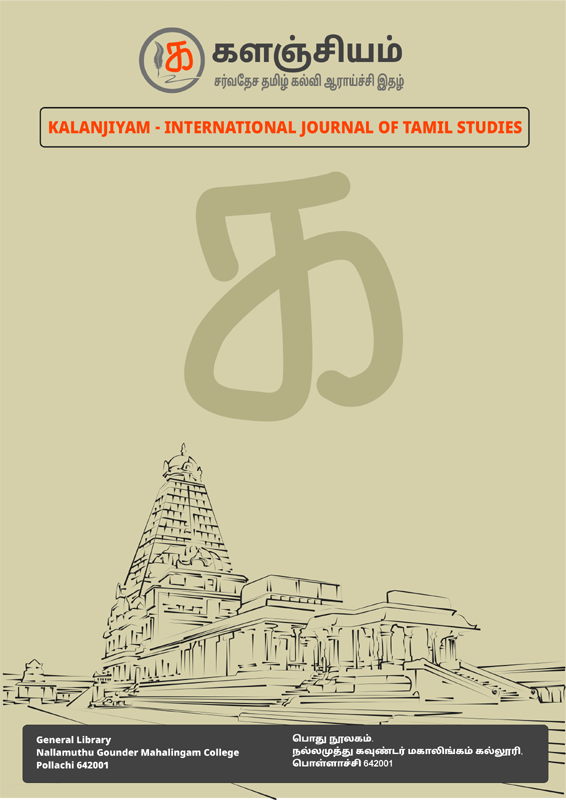பழமொழி நானூற்றில் அறம்
Virtue in the proverbial four hundred
Keywords:
Tamil Literature, Pazhamozhi, பழமொழிAbstract
மனித வாழ்க்கையை நல்லமுறையில் வாழ அறக்கருத்துக்கள் மிகவும் தேவை. இந்த அறக்கருத்துக்கள் வயல் வரப்புபோல தீங்கிலிருந்து தடுத்து வாழ்க்கையை வளமாக்க முக்கியப் பங்கு வகிக்கின்றன. அறக்கருத்துக்கள் மனிதனின் வாழ்வைச்; செப்பனிடும் ஒரு கருவியாக விளங்குகின்றன. ஒரு சமூகம் செம்மையானதாக விளங்க அறக்கருத்துக்கள் உள்ளும், புறமும் நின்று சீராக்கி சமூகத்தைச்; சிறக்கச் செய்கின்றன. ‘செத்தஎலி இறப்பிலே இருந்தாலும், கீழே இடுக்கிலே இருந்தாலும் வீடே நாறும்’. இதுபோல ஒழுக்கம் கெட்டவர்கள் உயர்மட்டத்தில் இருந்தாலும் அடிமட்டத்தில் இருந்தாலும் சமுதாயத்திற்குரிய மரியாதை கிடைக்காது. தமக்குத்தாமே ஏற்படுத்திற்கொண்ட ஒழுக்கக் கட்டுப்பாடுடன் வாழாத மனித சமுதாயம் என்றும் உயர்வு பெறாது. மனித வாழ்க்கை சிறக்க அறக்கருத்துக்கள் தேவை.
அவ்வகையில் தமிழினத்தின் செம்மையான நல்வாழ்விற்கு உதவும் அறிவொளி விளக்கங்களாகப் பழமொழிகள் விளங்குகின்றன. சுருங்கக் கூறின் விளக்க வைக்கும் தெளிவுரைகளாகவும் அவை விளங்குகின்றன. பழமொழிக்கு முதுமொழி என்ற பெயரும் உண்டு. முதுமொழியின் இலக்கணத்தைத் தொல்காப்பியனார் அக்காலத்திலேயே வரையறுத்துக் கூறியுள்ளார். ஓவ்வொரு பழமொழியையும் கூறி அதற்கு ஒரு நீதியை விளக்கும் செய்யுளாக மொத்தம்; நானூறு செய்யுள்களால் அமைந்துள்ளது பழமொழி நானூறு. இப்படியாக ஒரு நூலை உருவாக்கி மக்களின் வாழ்வியல் மதிப்புகளைச் சீர்படுத்தவும், முறைப்படுத்தவும் பழமொழிகளைக் கொண்டு நிலைப்படுத்தவும் முயன்ற பெருமைக்குரியவர் முன்னுரை அரையனார். வாழ்வியல் அறங்களை பழமொழி வழியாக எடுத்துரைப்பதே இக்கட்டுரையின் நோக்கம்.
Upholding good conduct is fundamental to leading a fulfilling life. These values serve as a protective barrier against life’s challenges and are crucial for cultivating a meaningful existence. Moral principles illuminate one’s path like a lamp, guiding individuals even in their darkest moments. When a society embodies strong moral values, it thrives both inwardly and outwardly, fostering a supportive and secure community. Much like the saying "though a cow may die, the tether remains," a community's survival hinges on mutual respect, regardless of the status of its members. Societies that fail to abide by their own moral framework struggle to achieve a high standard of living. Thus, strong moral values are indispensable for the flourishing of civilization. In this context, proverbs encapsulate the essence of Tamil culture by offering wisdom for a better quality of life. These straightforward sayings provide clarity and understanding, illuminating the language itself. Known as primary language, a term introduced by ancient Tamil grammarians, proverbs underscore the significance of the basic rules that govern the language.
Downloads
References
சாரதா பதிப்பகம், ஜி.டி. சாந்தி அடுக்ககம், 3, ஸ்ரீகிரு~;ணாபுரம் தெரு, ராயப்பேட்டை,சென்னை – 14. முதற்பதிப்பு – ஏப்ரல் 2010.
திருக்குறள் உரை, செ. நல்லசாமி, வாழ்க வளமுடன் ஆப்செட், பிரிண்டர்ஸ் பிரைவேட் லிமிடெட், அரச்சலூரி – 638 101. முதற்பதிப்பு – 2019.
Downloads
Published
Issue
Section
License
Copyright (c) 2024 Dr. P.Parameswari (Author)

This work is licensed under a Creative Commons Attribution 4.0 International License.
Our journal adopts CC BY License Creative Commons Attribution 4.0 International License http://Creativecommons.org//license/by/4.0/ . It allows using, reusing, distributing and reproducing of the original work with proper citation.



